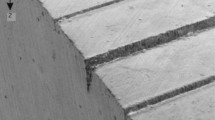Pulsed laser cutting of cavities in Al2O3–TiC-ceramic specimens is studied. It is established that cut cavities have external and internal regions whose size is determined by pulsed laser action regime parameters. Treated surface morphological features are revealed.




Similar content being viewed by others
Change history
25 May 2019
The following Acknowledgement is to be added to page 173 after the Conclusion:
References
R. V. Arutyunyan, V. Yu. Baranov, L. A. Bolshov, et al., Action of Laser Radiation on Materials [in Russian], Nauka, Moscow (1989).
E. D. Vaks, M. N. Milen’kii, and L. G. Saprykin, Precision Laser Treatment Practice [in Russian], Tekhnosfera, Moscow (2013).
Z. M. Xu, Z. H. Hong, G. Yang, and Q. G. Wang, “Research of artificial neural networks in the Al2O3 ceramic laser milling application,” Appl. Mech. Mater., 528, 101 – 106 (2014).
V. V. Kuzin, “Oxide ceramic surface layer modification using continuous laser radiation,” Refract. Indust. Ceram., 57(1), 53 – 57 (2016).
Y. H. Li, H. Xiao, G. Y. Li, J. Feng, and X. D. Li, “Fabrication of microchannels on SiC substrate by femtosecond laser,” Adv. Mater. Res., 557 – 559, 1322 – 1325 (2012).
M. Tomczyk, M. Walczak, and P. Sêk, “Laser technologies in microsystems,” Adv. Mater. Res., 874(1), 119 – 124 (2014).
V. Kuzin, S. Grigoriev,M. Fedorov,M. Portnoy, and V. Ermolin, “Surface modification of zirconia (Y-TZP) ceramics induced by pulsed laser machining,” Appl. Mech. Mater., 752/753, 481 – 484 (2015).
S. J. Dai, Y. G. Ren, T. Kong, and Y. L. Hu, “Research on ultra-precision machining of silicon nitride ceramics: a review,” Adv. Mater. Res., 497, 294 – 298 (2012).
V. V. Kuzin, M. R. Portnoi, S. Yu. Fedorov, and N. R. Portnoi “Features of pulsed laser radiation action on a ceramic VOK71 surface in water,” Refract. Indust. Ceram., 56(4), 394 – 397 (2015).
L. Rihakova and H. Chmelickova, “Laser micromachining of glass, silicon and ceramics. A review,” Eur. Int. J. Sci. Technol., 4(7), 41 – 49 (2015).
X. Chen, L. Ji, Y. Bao, and Y. Jiang, “Improving cutting quality by analysis of microstructure characteristics and solidification behaviour of recast layer formation on laser cut ceramic,” J. Eur. Ceram. Soc., 32(10), 2203 – 2211 (2012).
V. V. Kuzin, S. N. Grigor’ev, M. Yu. Fedorov, et al., “Effect of pulsed laser radiation on the surface of ceramic VOK71,” Refract. Indust. Ceram., 56(4), 390 – 393 (2015).
D. Teixidor, M. Grzenda, A. Bustillo, et al., “Modeling pulsed laser micromachining of micro geometries using machine-learning techniques,” J. Intell. Manuf., 26(4), 801 – 814 (2015).
Author information
Authors and Affiliations
Corresponding author
Additional information
Translated from Novye Ogneupory, No. 3, pp. 64 – 68, March, 2018.
Rights and permissions
About this article
Cite this article
Kuzin, V.V., Grigor’ev, S.N., Fedorov, M.Y. et al. Physical and Technological Aspects of Pulsed Laser Cutting of Cavities in Ceramics. Refract Ind Ceram 59, 170–174 (2018). https://doi.org/10.1007/s11148-018-0200-x
Received:
Published:
Issue Date:
DOI: https://doi.org/10.1007/s11148-018-0200-x




